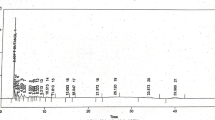Abstract
The species Sclerocarya birrea, also known as Marula, is present in Sub-Saharan Africa. In Burkina Faso, the leaves are sold as a traditional improved medicine with antidiabetic indication. The objective of this study was to develop a simple, rapid and robust high-performance thin-layer chromatographic (HPTLC) method for the reliable quality control of S. birrea leaves in Burkina Faso and other West African countries. Chromatography was performed using HPTLC Si 60 F254 plates (20 × 10 cm) as the stationary phase and ethyl acetate‒formic acid‒water (80:10:10, V/V) as the mobile phase. Derivatization steps using natural product and anisaldehyde reagents were used after the development for the detections of flavonoids and triterpenoids. Detection was carried out prior to and after derivatization under UV 254 nm, 366 nm and white light. The HPTLC method was successfully applied to the analysis of 182 collected samples including different origins, related herbal drugs (different plant parts, confounding species) and 12 traditional improved medicines in different forms (capsule, powdered sample, tea). The method was then adapted for use in quality control at different levels in developing countries.











Similar content being viewed by others
References
Eklu-Natey RD, Balet A, Médicine T (2012) Pharmacopée africaine: dictionnaire et monographies multilingues du potentiel médicinal des plantes africaines: Afrique de l’Ouest. Éditions d’en bas, Lausanne
Thiombiano A, Schmidt M, Dressler S, Ouédraogo A, Hahn K, Zizka G (2012) Catalogue des plantes vasculaires du Burkina Faso, vol. 65. Genève
Spichiger RE, Perret M, Figeat-Hug M, Jeanmonod D (2002) Botanique systématique des plantes à fleurs: une approche phylogénétique nouvelle des angiospermes des régions tempérées et tropicales. Presses polytechniques et universitaires romandes, Enfield N.H
Arbonnier M (2019) Arbres, arbustes et lianes d’Afrique de l’Ouest. Quae éditions, Versaille
Lebrun JP, Stork AL, Cribb PJ (2003) Tropical African flowering plants: ecology and distribution. vol 10. Ed. des Conservatoire et Jardin botaniques, Geneve
Mariod A, Abdelwahab S (2012) Sclerocarya birrea (Marula), An African tree of nutritional and medicinal uses: a review. Food Rev Int 28
Reich E, Frommenwiler DA, Maire-Widmer V (2015) Chapter 15: high-performance thin-layer chromatography for the identification of botanical materials and the detection of adulteration. In: Reynertson K, Mahmood K (eds) Botanicals: methods and techniques for quality & authenticity. CRC Press, Boca Raton, FL
European Pharmacopoeia, High-performance thin-layer chromatography of herbal drugs and herbal drug preparations. General Chapter 2.8.25, 9.2 edn., Strasbourg
United States Pharmacopeia, General Chapter<203>, USP 42-NF 37 Second Supplement (2019). Rockville, MD
Frommenwiler DA, Booker A, Vila R, Heinrich M, Reich E, Cañigueral S (2019) Comprehensive HPTLC fingerprinting as a tool for a simplified analysis of purity of ginkgo products. J Ethnopharmacol 243:112084
European Pharmacopoeia, Loss on drying (2019). 2.2.32, 10th edn., Strasbourg
Prinsloo G, Street RA (2013) Marula Sclerocarya birrea (A.Rich) Hochst]: a review of traditional uses, phytochemistry, and pharmacology. In: African natural plant products volume II: discoveries and challenges in chemistry, health, and nutrition, vol. 1127. ACS Symposium Series, vol. 1127. American Chemical Society, Washington, DC, pp 19–32
Belemtougri R, Traore A, Ouedraogo Y, Sanou S, Sawadogo L (2006) Toxicological effects of Sclerocarya birrea (A. Rich) Hochst (Anacardiaceae) and Psidium guajava L. (Myrtaceae) leaf extracts on mice and their pharmacological effects on rat duodenum. Pharmacology 2(5):557–562
Wagner H, Bladt S, Rickl V (1996) Plant drug analysis: a thin layer chromatography atlas. Springer, Berlin
Reich E, Schibli A (2011) High-performance thin-layer chromatography for the analysis of medicinal plants. Thieme, New York, NY
Acknowledgements
The authors thank the Conservatoire et Jardin Botaniques de la ville de Genève (Dr. Louis Nusbaumer), the Actions Tenga Association (www.actionstenga.org), and Dr. Assane Diop for providing samples, and Dr. V. Dakuyo of Laboratoire Phytofla (www.laboratoiresphytofla.com) for providing Diabefla® products.
Author information
Authors and Affiliations
Corresponding author
Electronic supplementary material
Below is the link to the electronic supplementary material.
Rights and permissions
About this article
Cite this article
Do, T.K.T., Clark, K., Christen, P. et al. Quality assessment of Sclerocarya birrea leaves and leaves products from Burkina Faso based on fingerprinting using HPTLC. JPC-J Planar Chromat 33, 439–448 (2020). https://doi.org/10.1007/s00764-020-00058-5
Received:
Accepted:
Published:
Issue Date:
DOI: https://doi.org/10.1007/s00764-020-00058-5




